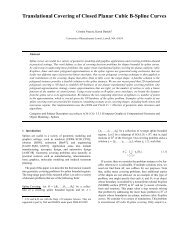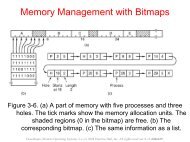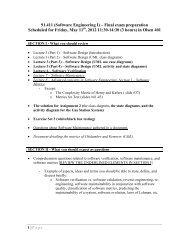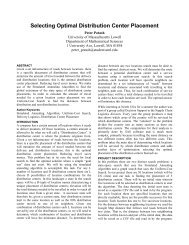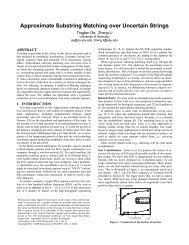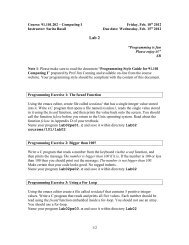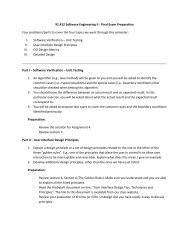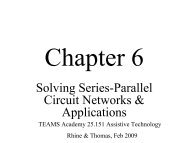A New Replay Attack Against Anonymous Communication Networks
A New Replay Attack Against Anonymous Communication Networks
A New Replay Attack Against Anonymous Communication Networks
Create successful ePaper yourself
Turn your PDF publications into a flip-book with our unique Google optimized e-Paper software.
1<br />
A <strong>New</strong> <strong>Replay</strong> <strong>Attack</strong> <strong>Against</strong> <strong>Anonymous</strong><br />
<strong>Communication</strong> <strong>Networks</strong><br />
Ryan Pries, Wei Yu, Xinwen Fu and Wei Zhao<br />
Abstract— Tor is a real-world, circuit-based low-latency anonymous<br />
communication network, supporting TCP applications on<br />
the Internet. In this paper, we present a new class of attack,<br />
the replay attack, against Tor. Compared with other existing attacks,<br />
the replay attack can confirm communication relationships<br />
quickly and accurately and poses a serious threat against Tor. In<br />
this attack, a malicious entry onion router duplicates cells of a<br />
stream from a sender. The original cell and duplicate cell traverse<br />
middle onion routers and arrive at an exit onion router along<br />
a circuit. Since Tor uses the counter mode AES (AES-CTR) for<br />
encryption of cells, the duplicate cell disrupts the normal counter<br />
at middle and exit onion routers and the decryption at the exit<br />
onion router incurs cell recognition errors. If an accomplice of<br />
the attacker at the entry onion router controls the exit onion<br />
router and detects such decryption errors, the communication<br />
relationship between the sender and receiver will be discovered.<br />
The replay attack can also be used as a denial of service attack.<br />
We implement the replay attack on Tor and our experiments<br />
validate the feasibility and effectiveness of the attack. We also<br />
present guidelines to defending against the replay attack.<br />
Index Terms— <strong>Replay</strong> <strong>Attack</strong>, Tor, Anonymity, Mix <strong>Networks</strong>,<br />
AES<br />
I. INTRODUCTION<br />
Concerns about privacy and security have received greater<br />
attention with the rapid growth and public acceptance of the<br />
Internet and the pervasive deployment of various wireless<br />
technologies. Anonymity has become a necessary and legitimate<br />
aim in many applications, including anonymous web<br />
browsing, location-based services (LBS) and E-voting. In these<br />
applications, encryption alone cannot maintain the anonymity<br />
required by participants [1], [2], [3].<br />
Since Chaum pioneered the basic idea of anonymous<br />
communication systems, referred to as mixes [4], in 1981,<br />
researchers have developed various anonymity systems for<br />
different applications. Mix techniques can be used for either<br />
message-based (high-latency) or flow-based (low-latency)<br />
anonymity applications. Email is a typical message-based<br />
anonymity application, which has been thoroughly investigated<br />
[5], [6]. Research on flow-based anonymity applications has<br />
been active in recent years to preserve anonymity in lowlatency<br />
applications, such as web browsing and peer-to-peer<br />
file sharing [7], [8].<br />
Tor [8] is a popular low-latency anonymous communication<br />
network, supporting TCP applications on the Internet. At the<br />
time that this paper was written, there are 1044 Tor routers<br />
Xinwen Fu (corresponding author) and Ryan Pries are with the College of<br />
Business and Information Systems, Dakota State University, 820 N. Washington<br />
Ave. Madison, SD 57042 (Email:{Xinwen.Fu, priesr}@dsu.edu). Wei Yu<br />
is with the Department of Computer Science, Texas A&M University, 301 Harvey<br />
R. Bright Bldg, College Station, TX 77843 (Email: weiyu@cs.tamu.edu).<br />
Wei Zhao is with School of Science, Rensselaer Polytechnic Institute, 110 8th<br />
Street, Troy, NY 12180-3590 (Email: zhaow3@rpi.edu).<br />
(i.e. onion routers) operating around the world, which form<br />
an overlay-based mix network 1 . To communicate with an<br />
application server, a Tor client selects an entry onion router,<br />
a middle onion router and an exit onion router in the case of<br />
default path length of 3. A circuit is built through this chain<br />
of 3 onion routers and the client negotiates a session key with<br />
each onion router. Then, application data is packed into cells,<br />
encrypted in an onion-like way and transmitted through the<br />
circuit to the server [8].<br />
There has been extensive research work done on attacks<br />
degrading anonymous communication through Tor. Most existing<br />
approaches are based on traffic analysis [3], [9], [10],<br />
[11], [12], [13], [14]. Specifically, to determine whether Alice<br />
is communicating with Bob through Tor, the traffic-analysis<br />
attacks measure the similarity between the sender’s outbound<br />
traffic and the receiver’s inbound traffic in order to confirm<br />
their communication relationship. However, traffic-analysis<br />
attacks may have a high rate of false positives due to various<br />
factors such as Internet traffic dynamics and need a series of<br />
packets for statistical analysis.<br />
In this paper, we present a new attack against Tor, the<br />
replay attack, which does not rely on traffic analysis and can<br />
confirm the communication relationship on Tor quickly and<br />
accurately, posing a serious threat against Tor. In the replay<br />
attack, an attacker may control multiple onion routers, similar<br />
to other exiting attacks [11], [3]. A malicious entry onion<br />
router duplicates cells of a TCP stream from a sender. The<br />
original cells and duplicate cells traverse middle onion routers<br />
and arrive at an exit onion router along a circuit. Tor uses the<br />
counter mode of Advanced Encryption Standard (AES-CTR)<br />
for encryption and decryption of cells at onion routers. The<br />
duplicate cell will disrupt the normal counter at the middle<br />
and exit onion routers and the decryption at the exit onion<br />
router will incur cell recognition errors. If an accomplice of<br />
the attacker at the entry onion router controls the exit onion<br />
router and detects such decryption errors, the communication<br />
relationship between the sender and receiver is discovered.<br />
We implement the replay attack on Tor and our experiments<br />
validate the feasibility and effectiveness of the replay attack.<br />
This replay attack also poses a great threat against the availability<br />
of the anonymity service provided by Tor. We give<br />
guidelines on countermeasure against the replay attack. The<br />
replay attack presented in this paper is one of the first to exploit<br />
the Tor implementation.<br />
The remainder of this paper is organized as follows: We<br />
introduce the basic operation of Tor in Section II. We present<br />
the details of the replay attack including the basic principle,<br />
1 In this paper, we use Tor router and onion router interchangeably. For<br />
brevity, router is used for the same purpose and the meaning should be clear<br />
from the context.
2<br />
algorithms and some discussion in Section III. In Section IV,<br />
we present our experiments on Tor to validate our findings.<br />
We give guidelines on countermeasures to the replay attack in<br />
Section V. We review related work in Section VI and conclude<br />
this paper in Section VII.<br />
II. BASIC OPERATION OF TOR<br />
In this section, we introduce components of the Tor network,<br />
the basic operation of Tor, including circuit setup and its usage<br />
for transmitting anonymous TCP streams.<br />
A. Components of the Tor Network<br />
Tor is a popular overlay network for anonymous communication<br />
on the Internet. It is an open source project and<br />
provides anonymity service for TCP applications [15]. Figure<br />
1 illustrates the basic entities of Tor [16].<br />
As shown in Figure 1, there are four basic entities:<br />
1) Alice (i.e. Client). The client runs local software called<br />
an onion proxy (OP) to anonymize the client data into<br />
the Tor network.<br />
2) Bob (i.e. Server). It runs TCP applications such as a web<br />
service and anonymously communicates with Alice.<br />
3) Onion routers (OR). Onion routers are special proxies<br />
that relay the application data between Alice and Bob.<br />
In Tor, Transport Layer Security (TLS) connections are<br />
used for the overlay link encryption between two onion<br />
routers. The application data is packed into equal-sized<br />
cells (512 bytes as shown in Figure 2) carried through<br />
TLS connections.<br />
4) Directory servers. They hold onion router information.<br />
There are directory authorities and directory caches.<br />
Directory authorities hold authoritative information on<br />
onion routers. Directory caches download directories of<br />
onion router information from authorities. Clients download<br />
the onion router directory from directory caches.<br />
Alice<br />
(OP)<br />
Entry<br />
(OR1)<br />
Tor Network<br />
Middle<br />
(OR2)<br />
Fig. 1.<br />
Exit<br />
(OR3)<br />
Tor Network<br />
Bob<br />
Functions of onion proxy, onion router and directory servers<br />
are integrated into the same Tor software package. A user can<br />
edit a configuration file and configure a computer to have any<br />
combination of those functions.<br />
Figure 2 illustrates the Tor cell format. All cells have a<br />
three-bytes header, which is not encrypted in the onion-like<br />
fashion so that the intermediate Tor routers can see this header.<br />
The other 509 bytes are encrypted in the onion-like way. There<br />
are two types of cells: control cell in Figure 2 (a) or relay<br />
¦§¨©©© ¨© ¡¢¡£¤¥<br />
¨©©©<br />
cell in Figure 2 (b). The control cell commands (CMD) are:<br />
padding (used for keepalive and optionally usable for link<br />
padding, although not used currently); create or created (used<br />
to set up a new circuit); and destroy (to tear down a circuit).<br />
The relay cell has an additional header (the relay header).<br />
There are numerous types of relay commands that routinely<br />
traverse the circuit, such as relay begin, relay data, relay<br />
end, relay sendme, relay extend, relay drop, and relay resolve<br />
(defined in or.h) [16]. We will explain them in later sections<br />
when we discuss Tor operations.<br />
2<br />
1<br />
509<br />
CircID CMD StreamID Digest Len Data CMD<br />
(a) Tor Cell Format<br />
2 1 2 6 2 1<br />
CircID Relay StreamID Digest Len CMD<br />
(b) Tor Relay Cell Format<br />
Fig. 2. Tor Cell Format [8]<br />
B. Selecting a Path and Creating a Circuit<br />
498<br />
Data<br />
To anonymously browse a web server, a client uses a way<br />
of source routing and chooses a series of onion routers from<br />
the locally cached directory, downloaded from the directory<br />
caches [17]. We denote the series of onion routers as the path<br />
through Tor [18]. The number of onion routers is referred to<br />
as the path length. We take the default path length of 3 as<br />
an example in Figure 1 to illustrate how the path is chosen.<br />
The client first chooses an appropriate exit onion router OR3,<br />
which should have an exit policy supporting the relay of the<br />
TCP stream from the sender. Then, the client chooses an<br />
appropriate entry onion router OR1 (referred to as the entry<br />
guard, which is used to prevent certain profiling attacks) and<br />
a middle onion router OR2.<br />
Alice<br />
Entry OR Middle OR Exit OR<br />
(OP)<br />
(OR1)<br />
(OR2)<br />
(OR3)<br />
(link is TLS-encrypted) (link is TLS-encrypted) (link is TLS-encrypted) (unencrypted)<br />
Create C1,<br />
E(g^x1)<br />
Created C1,<br />
g^y1, H(K1)<br />
Relay C1,<br />
{Extend, OR2, E(g^x2)}<br />
Relay C1,<br />
{Extended, g^y2, H(K2)}<br />
Create C2,<br />
E(g^x2)<br />
Created C2<br />
g^y2, H(K2)<br />
Relay C1,<br />
Relay C2,<br />
{{Extend, OR3, E(g^x2)}} {{Extend, OR3, E(g^x2)}}<br />
Relay C1,<br />
{{Extend, g^y3, H(K3)}}<br />
Relay C2<br />
{Extend, g^y3, H(K3)}<br />
Legend:<br />
E(x) --- RSA encryption<br />
{X} --- AES encryption<br />
CN --- a circuit ID numbered N<br />
Create C3,<br />
E(g^x2)<br />
Created C3<br />
Extend, g^y3, H(K3)<br />
t t t t t<br />
Fig. 3. Tor Circuit Creation [8]<br />
Once the path is chosen, the client initiates the process of<br />
creating a circuit over the path incrementally, one hop at a<br />
Bob
3<br />
time. Figure 3 illustrates the procedure of creating a circuit<br />
when the path has a default length of 3. Tor uses TLS/SSLv3<br />
for link authentication and encryption. In Figure 3, OP first<br />
sets up a TLS connection with OR1 using the TLS protocol.<br />
Then tunneled through this connection, OP sends a create<br />
cell and uses the Diffie-Hellman (DH) handshake protocol<br />
to negotiate a forward symmetric key, kf 1 , and a backward<br />
symmetric key, kb 1 , with OR1, which responds with a created<br />
cell. Therefore, a one-hop circuit, C1, is created.<br />
To extend the circuit one hop further, the OP sends to<br />
OR1 a relay extend cell, specifying the address of the next<br />
onion router, i.e., OR2 in Figure 3. This relay extend cell<br />
is encrypted by AES in the counter mode (AES-CTR) with<br />
kf 1 . Once OR1 receives this cell, it decrypts the cell and<br />
negotiates secret keys with OR2 using the DH handshake<br />
protocol. Therefore, a second segment C2 of the 2-hop circuit<br />
is created. OR1 sends OP a relay extended cell, which holds<br />
information for OP generating the shared secret keys, forward<br />
key kf 2 and backward key kb 2 , with OR2. This relay extended<br />
cell is encrypted by AES-CTR with key kb 1 . OP will decrypt<br />
the relay extended cell and use the information to create the<br />
corresponding keys. Encryption of late cells by these secret<br />
keys uses AES-CTR too.<br />
Consequently, to extend the circuit to a 3-hop circuit, OP<br />
sends OR2 a relay extend cell, specifying the address of the<br />
third onion router, i.e., OR3 in Figure 3, through the 2-hop<br />
circuit. As we can see, the cell is encrypted in an onion-like<br />
way [16]. The payload is first encrypted by kf 1 and then<br />
by kf 2 . The encrypted cell, like an onion, becomes thinner<br />
when it traverses an onion router, which removes one layer of<br />
onion skin by decrypting the encrypted cell. Therefore, when<br />
OR2 decrypts the cell, it discovers that the cell is meant to<br />
create another segment of the circuit to OR3. OR2 negotiates<br />
with OR3 and sends a relay extended cell back to OP. This<br />
cell is first encrypted by kb 2 at OR2 and then by kb 1 at<br />
OR1. OP decrypts the encrypted backward onion-like cell and<br />
derives the shared secret keys with OR3, forward key kf 3 and<br />
backward key kb 3 .<br />
In summary, OP negotiates secret keys with the three onion<br />
routers one by one and consequently creates a circuit along<br />
the path 2 . With the exception that the connection from the<br />
exit onion router to the server is not link encrypted, other<br />
connections along the path are protected by TLS within Tor.<br />
That is, cells encrypted in the onion-like way are also protected<br />
by link encryption.<br />
C. Transmitting TCP Streams<br />
Without loss of generality, we will use a short TCP stream,<br />
transferring 5 bytes of data “Hello” from Alice (OP) to Bob, as<br />
the example to illustrate how a TCP stream is tunneled through<br />
the circuit that has already been created. Figure 4 illustrates<br />
this simple example. Recall that at this stage, a client’s OP<br />
has established secret keys with other onion routers and can<br />
encrypt the application payload.<br />
To transmit TCP data to Bob, Alice’s application (such<br />
as web browser) contacts the OP, which is implemented as<br />
2 Each onion router checks a flag within the cell to determine whether the<br />
cell reaches its end. In this way, the encrypted cell has a fixed size and its<br />
length does not swell as in the public key encryption case [4]<br />
Alice<br />
Entry OR Middle OR Exit OR<br />
(OP)<br />
(OR1)<br />
(OR2)<br />
(OR3)<br />
(link is TLS-encrypted) (link is TLS-encrypted) (link is TLS-encrypted) (unencrypted)<br />
Relay C1,<br />
{{{Begin}}}<br />
Relay C1,<br />
{{{Connected}}}<br />
Relay C1,<br />
{{{Data, “Hello”}}}<br />
Relay C1,<br />
{{{End, Reason}}}<br />
Relay C2,<br />
{{Begin}}<br />
Relay C2,<br />
{{Connected}}<br />
Relay C2,<br />
{{Data, “Hello”}}<br />
Relay C2,<br />
{{End, Reason>}}<br />
Relay C3,<br />
{Begin}<br />
Relay C3,<br />
{Connected}<br />
Relay C3,<br />
{Data, “Hello”}<br />
Relay C3,<br />
{End, Reason}<br />
TCP Handshake<br />
<br />
“Hello”<br />
TCP Teardown<br />
t t t t t<br />
Fig. 4.<br />
TCP Connection Creation on Tor<br />
a SOCKS proxy locally. The OP learns the destination IP<br />
address and port. OP sends a relay begin cell to the exit<br />
router OR3, and the cell is encrypted {{{Begin < IP,Port ><br />
} kf3 } kf2 } kf1 , where the subscript refers to the key used for<br />
encryption of one onion skin. The three layers of onion skin<br />
are removed one by one each time the cell traverses an onion<br />
router through the circuit. When OR3 removes the last onion<br />
skin by decryption, it recognizes the request of opening a TCP<br />
stream to the port at the destination IP, which belongs to Bob.<br />
Therefore, OR3 acts as a proxy and builds a TCP connection<br />
with Bob and sends a relay connected cell back to Alice’s<br />
OP. The OP then accepts data from Alice’s application and<br />
transmits it to Bob through the circuit. The whole process<br />
is transparent to Alice, although she needs to configure her<br />
application to use the OP. When Alice’s application has no<br />
data to transmit, it will tear down the connection to her OP.<br />
As shown in Figure 4, after 5 bytes of data “Hello” in a relay<br />
data cell is transmitted, Alice’s application tears down the<br />
connection to OP. The OP then sends a relay end cell to OR3<br />
and OR3 tears down the connection to Bob.<br />
III. REPLAY ATTACK<br />
In this section, we first introduce the basic principle of<br />
the replay attack and then present the detailed algorithms,<br />
followed by discussion.<br />
A. Basic Principle<br />
Figure 4 illustrates the basic principle of replay attack.<br />
Alice<br />
Entry OR Middle OR Exit OR<br />
(OP)<br />
(OR1)<br />
(OR2)<br />
(OR3)<br />
(link is TLS-encrypted) (link is TLS-encrypted) (link is TLS-encrypted) (unencrypted)<br />
Relay C1,<br />
{{{Begin}}}<br />
Relay C1,<br />
{{{Connected}}}<br />
Relay C1,<br />
{{{Data, “Hello”}}}<br />
Relay C1,<br />
{{{End, Reason}}}<br />
Relay C2,<br />
{{Begin}}<br />
Relay C2,<br />
{{Connected}}<br />
Relay C2,<br />
{{Data, “Hello”}}<br />
Relay C2,<br />
{{Data, “Hello”}}<br />
Relay C2,<br />
{{End, Reason>}}<br />
Relay C3,<br />
{Begin}<br />
Relay C3,<br />
{Connected}<br />
Relay C3,<br />
{Data, “Hello”}<br />
Relay C3,<br />
{End, Reason}<br />
TCP Handshake<br />
<br />
“Hello”<br />
TCP Teardown<br />
t t t t t<br />
Fig. 5.<br />
Relay C3,<br />
{Data, “Hello”}<br />
<strong>Replay</strong> <strong>Attack</strong> on Tor<br />
Bob<br />
Bob
4<br />
Recall that the purpose of this attack is to confirm that<br />
Alice is communicating with Bob. Assume that an attacker<br />
can gain control of the entry and exit routers used by a given<br />
circuit. The attack starts from the malicious entry router. The<br />
entry router first attempts to identify a target cell from the<br />
TCP stream data on a circuit and duplicate that cell. When<br />
the cell is duplicated, the cell’s source IP and the time of<br />
duplication will be logged. This duplicate cell traverses the<br />
circuit and consequently arrives at the exit router. The attacker<br />
at the malicious exit router should detect an error caused<br />
by this duplicate cell and record the time, the original cell’s<br />
destination IP address and port. In this way, it is confirmed that<br />
the target cell is using the entry router and exit router. Since<br />
the entry router knows the sender of the cell is Alice and<br />
the exit router knows its receiver is Bob, the communication<br />
relationship between the sender and receiver is confirmed.<br />
Now we explain in detail what causes the decryption error.<br />
When a data cell is duplicated at OR1, its decryption at OR2<br />
and OR3 fails because the cell’s onion layers are encrypted<br />
using AES in the counter mode and the counter is disturbed<br />
by the duplicate cell. In the counter mode, encryption and<br />
decryption need to keep a synchronized value, a counter. The<br />
encryption of a cell at the OP increases the AES counter by<br />
one. The three routers along the path increase the counter and<br />
decrypt the original cell successfully. When OR1 duplicates<br />
a cell, the duplicate cell causes OR2 and OR3 to increase<br />
the counter and this takes the client and routers out of<br />
synchronization. In the current Tor implementation, default<br />
actions to this alarm are: OR3 tears down the circuit and the<br />
client builds another circuit for continuous communication.<br />
B. Algorithms<br />
We implement the replay attack based on the Tor release<br />
version of 0.1.1.26 3 . To implement the replay attack, we need<br />
to modify the source code of the client, entry router and exist<br />
router. To make the replay attack successful, selecting the<br />
cell to be duplicated at the entry router and confirming the<br />
duplicate cell at the exit router are two important issues in the<br />
replay attack. We will present the detailed algorithms in the<br />
following.<br />
1) Selecting Cells To Be Duplicated: At an entry router, an<br />
attacker needs to carefully identify the cell to be duplicated. If<br />
a cell is selected during the circuit setup process, the duplicate<br />
cell passing through the entry router will cause numerous<br />
protocol errors and immediately cause circuits to fail upon<br />
their creation. Therefore, the replay attack needs to duplicate<br />
cells of TCP stream data. Because cells are encrypted, the<br />
only information we know about the cells are the circuit ID<br />
and cell’s type (control or relay) in the cell header at OR1.<br />
Obviously, the replay attack shall only work with relay cells.<br />
There are various feasible ways of determining the relay cells.<br />
From the process of creating a circuit in Figure 3, the attacker<br />
can determine when the circuit is built and TCP stream relay<br />
starts. Since the default path length is 3, the circuit is built if<br />
one Create and two Relay cells are transmitted on the forward<br />
path, and one Created cell and two Relay cells on the backward<br />
path.<br />
3 <strong>New</strong>er versions of Tor have not changed the algorithms involved in this<br />
paper.<br />
To detect cells containing TCP data, an attacker can observe<br />
if a connection is built from the exit Tor router to a server.<br />
Recall that an exit Tor router acts as a normal proxy and<br />
creates a TCP connection to the server. A connection setup<br />
between the exit to a server indicates that some client has<br />
started a TCP session communicating with the server. The<br />
connection teardown between the exit to the server indicates<br />
that the client stops the TCP session. The malicious exit router<br />
can detect such behavior and buffer cells containing TCP data<br />
for later replay.<br />
The attacker can even use a loop-control style to detect the<br />
status of the TCP stream. The attacker at the exit router has<br />
the full information of the target TCP connection and notifies<br />
the attacker at the entry router OR1. The attacker at OR1 can<br />
then choose which cells to duplicate. Since the attacker at the<br />
exit router knows everything about the TCP connection, it can<br />
also duplicate the response cells back to the client and the<br />
attacker at OR1 can detect the duplicate cells.<br />
The attacker can choose an appropriate time for replaying<br />
cells. Recall that once the replay happens, the corresponding<br />
circuit cannot be used any more because the AES counter<br />
is disturbed along the path. If the attacker replays the cells<br />
when a TCP connection is still running, the circuit will be torn<br />
down and the client will use other circuits to continue the TCP<br />
connection. The attacker may also replay the cells when the<br />
circuit is not occupied by any TCP connection and before the<br />
circuit is torn down normally. Such an attack will not degrade<br />
the TCP performance very much and can be stealthy.<br />
2) Confirming Duplicate Cells: Recall that when the cell<br />
duplication is applied at a malicious entry router, decryption<br />
errors will happen at the exit onion router if the TCP stream<br />
is using that circuit. The exit router records the destination<br />
IP address, port number and time stamp, and the entry router<br />
records the time stamp of duplicate cells. We use Network<br />
Time Protocol (NTP) to synchronize the time of the entry<br />
router and exit router. By correlating the time of sending<br />
the duplicate cell with time of the decryption error ocurring,<br />
we can confirm that the decryption is actually caused by<br />
cell duplication. In addition, since the entry router knows<br />
the sender of the TCP stream and the exit router knows the<br />
receiver of the TCP stream, the communication relationship<br />
between the sender and receiver is confirmed.<br />
C. Discussion<br />
As discussed above, the replay attack enables fast and accurate<br />
confirmation of the communication anonymized by Tor,<br />
posing great threats to the anonymity service. We now discuss<br />
it from various perspectives, such as its malicious impact, the<br />
issue of controlling Tor routers, and noise reduction.<br />
1) Broad Impacts: The replay attack is a very powerful one.<br />
As we can see, to identify the communication relationship of<br />
a TCP stream, the attack is only based on one single duplicate<br />
cell. The determination of duplicate cells is quite simple and<br />
can be carried out quickly and accurately. This makes the<br />
replay attack quite different from other existing traffic-analysis<br />
attacks, which requires tuning parameters and balancing the<br />
trade-off between the false positive and detect rate [19], [10],<br />
[3], [11], [13], [20]. The replay attack is also robust to the
5<br />
network size, traffic dynamics, and other anti-traffic analysis<br />
strategies such as batching schemes [2], [21].<br />
The replay attack can be malicious in various ways against<br />
the privacy service provided by Tor. First, it can be used to<br />
randomly profile both clients and servers hidden by Tor. For<br />
any client who uses a circuit across the entry router and exit<br />
router, the attacker can discover their Internet behavior and<br />
compromise their privacy. Second, the replay attack can also<br />
be used to launch additional attacks, such as denial-of-service.<br />
If the malicious entry router generates duplicate cells, it will<br />
cause corresponding exit routers to tear down connections.<br />
This may slow down Tor if there exist multiple malicious entry<br />
routers which keep sending such replay cells. In addition, Tor<br />
directory authorities monitor the activities of routers and may<br />
blacklist those routers which unexpectedly drop connections.<br />
Although those malicious entry routers are the root cause<br />
of the connection drop, those innocent exit routers become<br />
scapegoats. Due to the anonymity maintained by Tor, it is not<br />
trivial to trace back those malicious entry routers.<br />
2) Controlling Onion Routers: We have assumed that the<br />
attacker controls some entry and exit routers. This is a reasonable<br />
assumption due to the principle of Tor design, e.g.,<br />
voluntary-oriented operation. Anyone can set up entry routers<br />
and exit onion routers. As long as a router has a self-designed<br />
exit policy enabling access to external services, this router<br />
becomes an exit router. To become an entry router, a Tor router<br />
must meet some criteria. If a router has a mean time between<br />
failure (MTBF) not less than the median for active routers or<br />
at least 10 days, it becomes a stable router. A stable router<br />
can be promoted to an entry guard if its bandwidth is either<br />
at least the median among known active routers or at least<br />
250KB/s [17]. This set of criteria are not difficult to meet in<br />
the real-world. Experiments in Section IV-B will confirm this<br />
claim.<br />
The replay attack can be more flexible. The requirement of<br />
a malicious exit router is not necessary in the replay attack<br />
if an attacker can monitor outbound stream from an exit<br />
router. This kind of traffic monitoring capacity has been widely<br />
used by other exiting attacks [19], [10], [3], [11], [13], [20].<br />
To this end, using various network traffic monitoring tools,<br />
the attacker can record the destination address and port of<br />
outbound TCP streams from an exit router. If the duplicate<br />
cell is identified at an entry onion router and a TCP stream<br />
from this exit router aborts abruptly, this gives a positive sign<br />
that the TCP stream from the sender travels along that exit<br />
router, addressed to the corresponding receiver.<br />
3) Noise Reduction: We will now discuss the noise reduction<br />
related to the replay attack. The false positive of this<br />
attack comes from unexpected decryption errors caused by<br />
non-duplication events. Based on our month long experiments<br />
on exit routers in Tor, we have not recorded such unexpected<br />
errors. This confirms that the false positive rate of the replay<br />
attack against Tor is very low.<br />
In order to further decrease the false positive rate, the<br />
attacker may replay multiple buffered cells from a single<br />
TCP stream at the same time. For each duplicate cell, we<br />
assume that the detection rate and false positive rate of the<br />
replay attack is p d and p f , respectively. We now derive the<br />
detection rate P D and false positive rate P F for replaying n<br />
duplicate cells. When n decryption errors is detection at the<br />
exit Tor router, the probability that all errors are not caused<br />
by the duplicate cells is (1 − p d ) n , and the detection rate<br />
P D = 1 − (1 − p d ) n . The corresponding false positive rate is<br />
P F = p n f<br />
. Therefore, by choosing an appropriate n, an attacker<br />
can achieve a high detection rate and small false positive rate.<br />
IV. EVALUATION<br />
In this section, we use a real-world implementation to<br />
investigate the effectiveness and feasibility of the replay attack.<br />
A. Experiment Setup<br />
We carry out the experiment on Tor [22]. Figure 6 shows<br />
the experimental setup. We use two malicious onion routers<br />
as the Tor entry onion router and exit onion router. The entry<br />
router, client (Alice) and server (Bob) is located in an office<br />
on campus 4 . The exit onion router is located in an off-campus<br />
location. Machines on campus and off-campus are on different<br />
public IP segments connecting to different ISPs.<br />
Campus<br />
Client<br />
Malicious<br />
Entry Router<br />
Fig. 6.<br />
Tor Network<br />
Experiment Setup<br />
Off-Campus<br />
Malicious<br />
Exit Router<br />
Server<br />
To reduce the impact of the replay attack on Tor’s normal<br />
behavior, we conduct experiments in a partially controlled<br />
environment. We change segments of Tor client code for<br />
debugging purposes. The Tor client would only build circuits<br />
through the designated malicious exit onion router and the designated<br />
entry onion router in Figure 6. The middle onion router<br />
is selected using the normal Tor routing selection algorithm.<br />
Recall that the goal of the replay attack is to confirm that<br />
the client is communicating to the server. We create a small<br />
client and server application to send and receive data through<br />
TCP. The test server binds to port 41 and receives packets<br />
and displays relevant connection information to the screen for<br />
debugging and measurement. The Tor client utilizes tsocks [23]<br />
to automatically transport its outbound TCP stream through<br />
the OP using SOCKS. By using the Tor configuration file<br />
and manipulating parameters, such as EntryNodes, ExitNodes,<br />
StrictEntryNodes, and StrictExitNodes [18], we setup the client<br />
to select the malicious onion routers along the circuit. The exit<br />
onion router uses the default exit policy from Tor and the entry<br />
onion router’s exit policy only allows it to be used as an entry<br />
or middle onion router.<br />
B. Experimental Results<br />
The publicly available bandwidth information of onion<br />
routers from the Tor directory servers confirm that the set of<br />
4 The office is located at Dakota State University campus
6<br />
criteria for becoming an entry onion router are not difficult to<br />
meet. Figure 7 shows the onion router’s bandwidth distribution<br />
on Tor based on directory information collected 10:30am on<br />
August 18, 2007. The mean value of the bandwidth is only<br />
around 57KB/s. After running for about 5 days, our entry<br />
router with a bandwidth of 200KB/s became an entry guard.<br />
F(x)<br />
1<br />
0.8<br />
0.6<br />
0.4<br />
0.2<br />
0 1000 2000 3000 4000 5000<br />
(a) Box−and−whisker diagram<br />
1<br />
0<br />
0 1000 2000 3000 4000 5000<br />
Bandwidth (KB/s)<br />
(b) Cummulative probability function median=57KB/s<br />
Fig. 7. Onion Routers’ Bandwidth Distribution on Tor: Bandwidth Median=57KB/s;<br />
(a) Box and Whisker Plot of Bandwidth; (b) Cumulative<br />
Distribution Function of Bandwidth<br />
Time of Decryption Error at Exit (s)<br />
550<br />
500<br />
450<br />
400<br />
350<br />
300<br />
250<br />
200<br />
150<br />
100<br />
50<br />
0<br />
0 100 200 300 400 500<br />
Time of Cell Duplication at Entry (s)<br />
Fig. 8. Correlation Between Time of Duplicating Cells and Time of Detecting<br />
Decryption Error<br />
In our experiments, the client sends a message packed in<br />
one cell to the server every 10 seconds. The revised code for<br />
the entry onion router records the time of duplicating the data<br />
cell. and the revised code for the exit onion router records<br />
the time of decryption error and carry out the detection. We<br />
use the correlation coefficient r to measure the strength of<br />
correlation between the time of generating duplicate cells and<br />
the time of observing decryption errors. Correlation coefficient<br />
(r=1)<br />
is defined in<br />
∑<br />
(x − ¯x)(y − ȳ)<br />
x,y<br />
r = √∑ √ ∑ , (1)<br />
(x − ¯x) 2 (y − ȳ) 2<br />
x<br />
y<br />
where x is the time of cells duplicated at the entry onion router<br />
and y is the time of decryption errors incurred at the malicious<br />
exit. ¯x and ȳ are the mean values of x and y, respectively.<br />
Figure 8 shows relationship between the time of duplicating<br />
data cells and the time of decryption errors. As we can<br />
see from this figure, there is a perfect positive match, since<br />
the actual correlation coefficient between them is one. This<br />
strongly confirms that the replay attack can indeed confirm<br />
the communication relationship if the sender and receiver are<br />
using Tor. In addition to its accuracy, the replay attack can be<br />
very fast, since it only needs to launch and recognize a single<br />
duplicate cell.<br />
V. GUIDELINE OF COUNTERMEASURES<br />
We have demonstrated the threat of the replay attack against<br />
Tor. We now discuss possible countermeasures to this attack.<br />
1) Minimizing Number of Compromised Entry Routers:<br />
Recall that the replay attack requires an attacker to fully<br />
control at least one entry onion router, which may advertise the<br />
false bandwidth resource and promote compromised servers<br />
to be entry onion routers of Tor. There are two possible<br />
ways to minimize the chance that compromised servers become<br />
entry onion routers. First, the path selection algorithm<br />
may be evolved and select only fully trusted and dedicated<br />
ones through strict authentication and authorization. Second,<br />
countermeasures may be developed to detect false bandwidth<br />
advertisements from an attacker’s Tor router trying to become<br />
Tor entry guards (Sybil attacks) [24]. For example, Tor’s path<br />
selection protocol can be augmented to allow onion routers<br />
to proactively monitor each other and validate other onion<br />
routers’ bandwidth [25]. A reputation system could also help<br />
facilitate this countermeasure. In this way, the attacker will<br />
have less of a chance to control the entry onion router and the<br />
effectiveness of replay attack will be reduced. However, this<br />
approach cannot completely address the replay attack, since<br />
the attacker can still contribute high bandwidth if it has the<br />
resources.<br />
2) Monitoring Duplicate Cells. Recall that the replay attack<br />
needs to send the duplicate cells. If duplicate cells can be<br />
detected and drop at the middle router before they reach<br />
the exit onion router, the effectiveness of the attack will be<br />
significantly reduced. To this end, one naive way is to allow<br />
the middle onion router along the circuit to detect duplicate<br />
cells by buffering historical cells. However, this will give more<br />
overhead to onion routers, since Tor requires using a pair of<br />
memory buffers for reading and writing data from each TCP<br />
stream [26].<br />
Another way to detect the replay attack is to have the Tor<br />
clients and exit routers monitor the connection for abnormality.<br />
Since the replay attack will cause connections to be torn<br />
down and a client to switch to another circuit, a frequent<br />
such connection teardown and circuit switch may indicate the<br />
possibility of the replay attack. But the client cannot rely on<br />
the reported reason of circuit teardown for this monitoring
7<br />
purpose since the malicious exit node may change the reason<br />
code. When a replay attack is used to confirm the communication<br />
relationship which does not exist, exit routers other than<br />
the malicious one will receive the duplicate cells and detect<br />
decryption errors. Such decryption errors may indicate a high<br />
possibility of the replay attack.<br />
VI. RELATED WORK<br />
Most attacks against low-latency flow-based anonymous<br />
communication networks proposed in the literature belong to<br />
the traffic-analysis attack. The basis of this class of attack is to<br />
determine whether Alice is communicating with Bob through<br />
an anonymous communication network based on measuring<br />
the similarity between Alice’s outbound traffic and Bob’s<br />
inbound traffic. For example, Zhu et al. [10] proposed the<br />
scheme of using mutual information for the traffic similarity<br />
measurement. Levine et al. [9] utilized a cross-correlation<br />
technique for the traffic similarity measurement. Murdoch et<br />
al. [11] investigated the traffic timing similarity on Tor by using<br />
some compromised Tor servers. Overlier et al. [3] studied<br />
an attack that uses one compromised mix node to identify the<br />
“hidden server” anonymized by Tor. Their approach is also<br />
based on the traffic timing similarity to associate circuits, and<br />
thereby locate the hidden servers. Bauer et al. [12] studied<br />
an attack that is based on some malicious onion routers and<br />
they use traffic analysis techniques. There are other attacks<br />
that intend to achieve both accuracy and invisibility [14].<br />
There is little research efforts that have been conducted on<br />
the non-traffic analysis based attacks. Murdoch [27] investigated<br />
an attack to reveal hidden servers of Tor by exploiting<br />
the fact that the clock deviations of a target server should be<br />
consistent with the server’s load. Differently, the replay attack<br />
studied in this paper exploits the fundamental design of Tor.<br />
This attack is powerful, capable of launching and detecting<br />
one single duplicate cell.<br />
VII. CONCLUSION<br />
In this paper, we introduced a new class of replay attack<br />
against Tor, and the attack can achieve fast and accurate<br />
confirmation of the anonymized communication relationship.<br />
In particular, an attacker at a malicious entry onion router<br />
duplicates data cells from the inbound TCP stream. The<br />
duplicate data cell will be carried along the circuit of Tor<br />
and causes decryption errors at a malicious exit onion router.<br />
Based on the high correlation between the time of duplicating<br />
cells at the entry onion router and receiving a decryption<br />
error at the exit onion router, the attacker can confirm the<br />
communication relationship between the sender and receiver<br />
accurately and quickly, significantly degrading the anonymity<br />
service provided by Tor. Via real-world implementation and<br />
experiments, effectiveness and feasibility of the replay attack<br />
are validated. The replay attack can also be used to blacklist<br />
Tor routers as a denial of service attack. Our study is critical<br />
for securing and improving Tor.<br />
Due to the Tor’s fundamental design, defending against<br />
the replay attack remain challenging tasks and we will investigate<br />
them in our future research. Also, we believe that<br />
other vulnerabilities exist in Tor and we plan to conduct a<br />
thorough investigation of them and develop corresponding<br />
countermeasures.<br />
REFERENCES<br />
[1] Q. X. Sun, D. R. Simon, Y. Wang, W. Russell, V. N. Padmanabhan, and<br />
L. L. Qiu, “Statistical identification of encrypted web browsing traffic,”<br />
in Proceedings of IEEE Symposium on Security and Privacy (S&P),<br />
May 2002.<br />
[2] X. Fu, Y. Zhu, B. Graham, R. Bettati, and W. Zhao, “On flow marking<br />
attacks in wireless anonymous communication networks,” in Proceedings<br />
of the IEEE International Conference on Distributed Computing<br />
Systems (ICDCS), April 2005.<br />
[3] L. Overlier and P. Syverson, “Locating hidden servers,” in Proceedings<br />
of the IEEE Security and Privacy Symposium (S&P), May 2006.<br />
[4] D. Chaum, “Untraceable electronic mail, return addresses, and digital<br />
pseudonyms,” <strong>Communication</strong>s of the ACM, vol. 4, no. 2, February 1981.<br />
[5] G. Danezis, R. Dingledine, and N. Mathewson, “Mixminion: design of a<br />
type iii anonymous remailer protocol,” in Proceedings of the 2003 IEEE<br />
Symposium on Security and Privacy (S&P), May 2003.<br />
[6] C. Gülcü and G. Tsudik, “Mixing email with babel,” in Proceedings<br />
of the Network and Distributed Security Symposium (NDSS), February<br />
1996.<br />
[7] M. Reiter and A. Rubin, “Crowds: Anonymity for web transactions,”<br />
ACM Transactions on Information and System Security, vol. 1, no. 1,<br />
1998.<br />
[8] R. Dingledine, N. Mathewson, and P. Syverson, “Tor: The secondgeneration<br />
onion router,” in Proceedings of the 13th USENIX Security<br />
Symposium, August 2004.<br />
[9] B. N. Levine, M. K. Reiter, C. Wang, and M. Wright, “Timing attacks<br />
in low-latency mix-based systems,” in Proceedings of Financial Cryptography<br />
(FC), February 2004.<br />
[10] Y. Zhu, X. Fu, B. Graham, R. Bettati, and W. Zhao, “On flow correlation<br />
attacks and countermeasures in mix networks,” in Proceedings of<br />
Workshop on Privacy Enhancing Technologies (PET), May 2004.<br />
[11] S. J. Murdoch and G. Danezis, “Low-cost traffic analysis of tor,” in<br />
Proceedings of the IEEE Security and Privacy Symposium (S&P), May<br />
2006.<br />
[12] K. Bauer, D. McCoy, D. Grunwald, T. Kohno, and D. Sicker, “Lowresource<br />
routing attacks against anonymous systems,” in Proceedings of<br />
ACM Workshop on Privacy in the Electronic Society (WPES), October<br />
2007.<br />
[13] X. Wang, S. Chen, and S. Jajodia, “Network flow watermarking attack<br />
on low-latency anonymous communication systems,” in Proceedings of<br />
the IEEE Symposium on Security & Privacy (S&P), May 2007.<br />
[14] W. Yu, X. Fu, S. Graham, D. Xuan, and W. Zhao, “Dsss-based flow<br />
marking technique for invisible traceback,” in Proceedings of the 2007<br />
IEEE Symposium on Security and Privacy (S&P), May 2007.<br />
[15] R. Dingledine, N. Mathewson, and P. Syverson, “Tor: anonymity online,”<br />
http://tor.eff.org/index.html.en, 2007.<br />
[16] R. Dingledine and N. Mathewson, “Tor protocol specification,” http:<br />
//tor.eff.org/svn/trunk/doc/spec/tor-spec.txt, 2007.<br />
[17] N. Mathewson, “Tor directory protocol, version 3,” http://tor.eff.org/svn/<br />
trunk/doc/spec/dir-spec.txt, 2007.<br />
[18] R. Dingledine and N. Mathewson, “Tor path specification,” http://tor.eff.<br />
org/svn/trunk/doc/spec/path-spec.txt, 2007.<br />
[19] M. Wright, M. Adler, B. N. Levine, and C. Shields, “Defending anonymous<br />
communication against passive logging attacks,” in Proceedings<br />
of the IEEE Symposium on Security and Privacy, May 2003.<br />
[20] W. Yu, X. Fu, S. Graham, D. Xuan, and W. Zhao, “Dsss-based flow<br />
marking technique for invisible traceback,” in Proceedings of the 2007<br />
IEEE Symposium on Security and Privacy (S&P), 2007 May.<br />
[21] A. Serjantov, R. Dingledine, and P. Syverson, “From a trickle to a flood:<br />
active attacks on several mix types,” in Proceedings of Information<br />
Hiding Workshop (IH), February 2002.<br />
[22] “Tor: anonymity online,” http://tor.eff.org/, 2007.<br />
[23] “A transparent socks proxying library,” http://tsocks.sourceforge.net,<br />
2007.<br />
[24] K. Bauer, D. McCoy, D. Grunwald, T. Kohno, and D. Sicker, “Lowresource<br />
routing attacks against anonymous systems,” University of<br />
Colorado at Boulder, Tech. Rep., August 2007.<br />
[25] K. Harfoush, A. Bestavros, and J. W. Byers, “Measuring bottleneck<br />
bandwidth of targeted path segments,” in Proceedings of the IEEE<br />
INFOCOM, April 2003.<br />
[26] “Theonionrouter/torfaq,” http://wiki.noreply.org/noreply/<br />
TheOnionRouter/TorFAQ, 2007.<br />
[27] S. J. Murdoch, “Hot or not: Revealing hidden services by their clock<br />
skew,” in Proceedings of the 13th ACM Conference on Computer and<br />
<strong>Communication</strong>s Security (CCS), November 2006.




